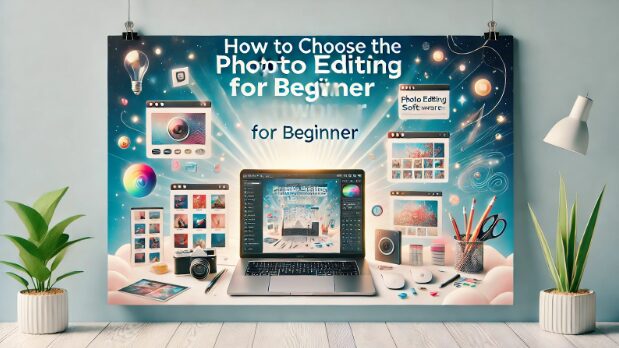For beginner photographers, selecting the right photo editing software is a critical step in the journey of creating stunning images. The sheer number of options available on the market today can make the process overwhelming, especially with the growing popularity of AI-powered tools. With the right photo editing software for beginners, a photographer can unlock new creative potential and improve their skills with ease.
In this post, we will examine the key factors to consider when choosing the best photo editing software, highlight important features, and discuss how AI is transforming the editing process. By the end, you’ll have a clearer understanding of which photo editing software for beginners is right for you.
Key Factors to Consider When Choosing Photo Editing Software for Beginners
Choosing the best photo editing software for beginners depends on various factors. These include ease of use, features, cost, compatibility, and the type of photography you specialize in. Whether you are a hobbyist, an aspiring professional, or simply looking to improve your photography skills, there’s a tool out there for you.
1. Ease of Use
For beginners, the software should not only provide powerful features but also be easy to navigate. It’s crucial to choose a program that offers an intuitive interface and helpful tools that don’t require extensive learning curves. Tools like Pykaso, Lightroom and Photoshop are well-known for their robust features, but they can be intimidating at first. For beginners, software such as Canva, Fotor, or GIMP might be a better fit, as they provide simpler interfaces and are still powerful enough for most editing tasks. These are excellent choices when looking for photo editing software for beginners.
2. Features
While features may vary depending on the software, certain basic editing tools are essential for any photographer. These include cropping, adjusting brightness and contrast, retouching, removing red-eye, and sharpening. More advanced features such as layers, masking, and blending modes allow you to create more complex edits.
- Basic adjustments: Exposure, contrast, saturation, and temperature adjustments.
- Retouching tools: Healing brush, clone tool, and red-eye correction.
- Layer support: Layers allow you to edit individual elements of an image without affecting the rest.
- AI-powered enhancements: Tools that help with tasks like noise reduction and object removal.
3. Price and Subscription Plans
The cost of photo editing software for beginners varies greatly, so it’s crucial to consider your budget. Some programs, like GIMP, are free to use but may require more effort to learn. Others, like Adobe Photoshop, come with a monthly subscription fee but offer a wealth of advanced features and cloud storage. Subscription-based models, like Adobe Creative Cloud, offer constant updates and access to additional software, while one-time purchase software like Affinity Photo allows for a more straightforward financial commitment. As a beginner, free or low-cost software is often the best choice when looking for photo editing software for beginners.
4. Compatibility
The software you choose must be compatible with your device. Most photo editing software works on both Windows and Mac, but some might not be available for mobile devices. In particular, apps like Snapseed or VSCO are great for mobile editing on iOS and Android devices. However, desktop tools like Lightroom and Photoshop are more suited to those who plan on doing more in-depth editing. For beginners, it’s essential to choose photo editing software for beginners that works well across the devices you plan to use.
5. Support and Tutorials
When learning a new tool, support and tutorials are invaluable. Many photo editing software options offer user-friendly guides and communities where users can ask questions and share their work. Look for software with a large online community and readily available tutorials, whether on the company’s website, YouTube, or user forums. This can be particularly useful for beginners trying to get up to speed quickly with photo editing software for beginners.
Features to Look for in Photo Editing Software for Beginners
When you’re just starting, the features you need in photo editing software for beginners can vary depending on your preferences. However, there are certain tools that will make your editing experience smoother.
- Non-Destructive Editing: This allows you to make changes to your photos without permanently altering the original image. This is important when you want to revert to the original or create multiple versions of the same image.
- RAW Support: If you shoot in RAW format, ensure the software supports it. RAW images contain more data and allow you more flexibility in editing.
- Preset Filters: These can save time and give you a quick starting point for your edits. Many beginner-friendly tools include presets, making it easy to achieve professional-looking results with minimal effort.
- Cloud Integration: Having cloud storage can be a lifesaver when working on multiple devices or collaborating with others. Some software offers integration with cloud services like Google Drive or Dropbox.
- AI Integration: AI is rapidly becoming a key player in photo editing. With AI-powered tools, you can easily swap faces, improve lighting, and even remove background distractions. These AI tools make editing more efficient, even for those who are still learning the ropes. AI integration is especially valuable in photo editing software for beginners, making complex edits easier.
Trends in Photo Editing for 2024
As technology advances, so does the way we approach photo editing. Here are some of the biggest trends in photo editing that are shaping the industry in 2024.
1. AI-Driven Tools
Artificial intelligence is taking over the photo editing world, making tasks easier and faster. AI-powered tools can automatically detect and correct issues in photos, such as adjusting exposure, color balance, and sharpness. Some AI tools can even identify objects in your images and suggest edits. For beginners, these tools make it easier to get professional results without needing advanced knowledge.
2. Mobile Editing Apps
With the rise of smartphones, mobile editing apps have gained massive popularity. Apps like Snapseed and Lightroom Mobile offer powerful editing features directly from your phone, making it easier to edit on the go. With the rise of mobile content creation, these apps are expected to continue evolving in 2024.
3. Cloud-Based Editing
Cloud-based photo editing software allows users to access their images and editing tools from anywhere, whether on a desktop, laptop, or mobile device. In 2024, we’ll see more photo editing software transition to the cloud, offering better collaboration features, faster processing, and the ability to sync across devices. This trend is especially beneficial for beginners who may need to edit photos on different platforms.
4. Video Editing Integration
More photo editing software is now offering basic video editing tools. As photography and videography continue to blur the lines, beginners are looking for software that can handle both photo and video editing. Programs like Adobe Premiere Pro and Photoshop are providing users with more flexibility by offering seamless integration between the two.
5. Virtual Reality (VR) and Augmented Reality (AR)
Virtual and augmented reality are also making their way into photo editing tools. These technologies allow photographers to interact with their images in more immersive ways. For example, AR can be used to apply real-time effects to images, while VR can provide a new, interactive way of editing photos. While this is still an emerging trend, it’s something to keep an eye on in the coming years.
Conclusion
Choosing the best photo editing software for beginner photographers depends on your specific needs, budget, and goals. The key is to balance ease of use, powerful features, and affordability.
As AI continues to shape the industry, you’ll find that there are more intuitive, efficient tools at your disposal. With the right software, your creative potential will only grow as you continue to improve your photography skills. Whether you’re looking to simply adjust a few photos or dive deeper into professional-level editing, there’s a solution available for every photographer.



































